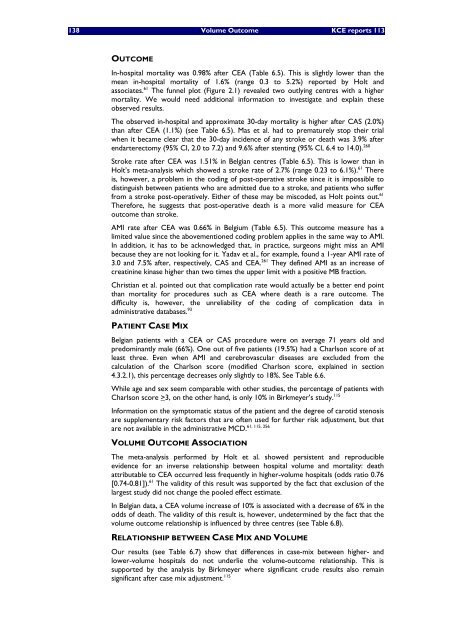Het volume van chirurgische ingrepen en de impact ervan op ... - KCE
Het volume van chirurgische ingrepen en de impact ervan op ... - KCE
Het volume van chirurgische ingrepen en de impact ervan op ... - KCE
Create successful ePaper yourself
Turn your PDF publications into a flip-book with our unique Google optimized e-Paper software.
138 Volume Outcome <strong>KCE</strong> reports 113<br />
OUTCOME<br />
In-hospital mortality was 0.98% after CEA (Table 6.5). This is slightly lower than the<br />
mean in-hospital mortality of 1.6% (range 0.3 to 5.2%) reported by Holt and<br />
associates. 61 The funnel plot (Figure 2.1) revealed two outlying c<strong>en</strong>tres with a higher<br />
mortality. We would need additional information to investigate and explain these<br />
observed results.<br />
The observed in-hospital and approximate 30-day mortality is higher after CAS (2.0%)<br />
than after CEA (1.1%) (see Table 6.5). Mas et al. had to prematurely st<strong>op</strong> their trial<br />
wh<strong>en</strong> it became clear that the 30-day incid<strong>en</strong>ce of any stroke or <strong>de</strong>ath was 3.9% after<br />
<strong>en</strong>darterectomy (95% CI, 2.0 to 7.2) and 9.6% after st<strong>en</strong>ting (95% CI, 6.4 to 14.0). 260<br />
Stroke rate after CEA was 1.51% in Belgian c<strong>en</strong>tres (Table 6.5). This is lower than in<br />
Holt’s meta-analysis which showed a stroke rate of 2.7% (range 0.23 to 6.1%). 61 There<br />
is, however, a problem in the coding of post-<strong>op</strong>erative stroke since it is impossible to<br />
distinguish betwe<strong>en</strong> pati<strong>en</strong>ts who are admitted due to a stroke, and pati<strong>en</strong>ts who suffer<br />
from a stroke post-<strong>op</strong>eratively. Either of these may be misco<strong>de</strong>d, as Holt points out. 61<br />
Therefore, he suggests that post-<strong>op</strong>erative <strong>de</strong>ath is a more valid measure for CEA<br />
outcome than stroke.<br />
AMI rate after CEA was 0.66% in Belgium (Table 6.5). This outcome measure has a<br />
limited value since the abovem<strong>en</strong>tioned coding problem applies in the same way to AMI.<br />
In addition, it has to be acknowledged that, in practice, surgeons might miss an AMI<br />
because they are not looking for it. Yadav et al., for example, found a 1-year AMI rate of<br />
3.0 and 7.5% after, respectively, CAS and CEA. 261 They <strong>de</strong>fined AMI as an increase of<br />
creatinine kinase higher than two times the upper limit with a positive MB fraction.<br />
Christian et al. pointed out that complication rate would actually be a better <strong>en</strong>d point<br />
than mortality for procedures such as CEA where <strong>de</strong>ath is a rare outcome. The<br />
difficulty is, however, the unreliability of the coding of complication data in<br />
administrative databases. 93<br />
PATIENT CASE MIX<br />
Belgian pati<strong>en</strong>ts with a CEA or CAS procedure were on average 71 years old and<br />
predominantly male (66%). One out of five pati<strong>en</strong>ts (19.5%) had a Charlson score of at<br />
least three. Ev<strong>en</strong> wh<strong>en</strong> AMI and cerebrovascular diseases are exclu<strong>de</strong>d from the<br />
calculation of the Charlson score (modified Charlson score, explained in section<br />
4.3.2.1), this perc<strong>en</strong>tage <strong>de</strong>creases only slightly to 18%. See Table 6.6.<br />
While age and sex seem comparable with other studies, the perc<strong>en</strong>tage of pati<strong>en</strong>ts with<br />
Charlson score >3, on the other hand, is only 10% in Birkmeyer’s study. 115<br />
Information on the symptomatic status of the pati<strong>en</strong>t and the <strong>de</strong>gree of carotid st<strong>en</strong>osis<br />
are supplem<strong>en</strong>tary risk factors that are oft<strong>en</strong> used for further risk adjustm<strong>en</strong>t, but that<br />
61, 115, 256<br />
are not available in the administrative MCD.<br />
VOLUME OUTCOME ASSOCIATION<br />
The meta-analysis performed by Holt et al. showed persist<strong>en</strong>t and reproducible<br />
evid<strong>en</strong>ce for an inverse relationship betwe<strong>en</strong> hospital <strong>volume</strong> and mortality: <strong>de</strong>ath<br />
attributable to CEA occurred less frequ<strong>en</strong>tly in higher-<strong>volume</strong> hospitals (odds ratio 0.76<br />
[0.74-0.81]). 61 The validity of this result was supported by the fact that exclusion of the<br />
largest study did not change the pooled effect estimate.<br />
In Belgian data, a CEA <strong>volume</strong> increase of 10% is associated with a <strong>de</strong>crease of 6% in the<br />
odds of <strong>de</strong>ath. The validity of this result is, however, un<strong>de</strong>termined by the fact that the<br />
<strong>volume</strong> outcome relationship is influ<strong>en</strong>ced by three c<strong>en</strong>tres (see Table 6.8).<br />
RELATIONSHIP BETWEEN CASE MIX AND VOLUME<br />
Our results (see Table 6.7) show that differ<strong>en</strong>ces in case-mix betwe<strong>en</strong> higher- and<br />
lower-<strong>volume</strong> hospitals do not un<strong>de</strong>rlie the <strong>volume</strong>-outcome relationship. This is<br />
supported by the analysis by Birkmeyer where significant cru<strong>de</strong> results also remain<br />
significant after case mix adjustm<strong>en</strong>t. 115

















